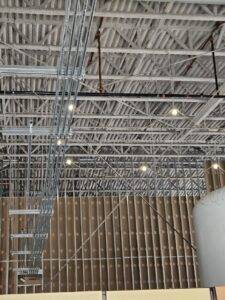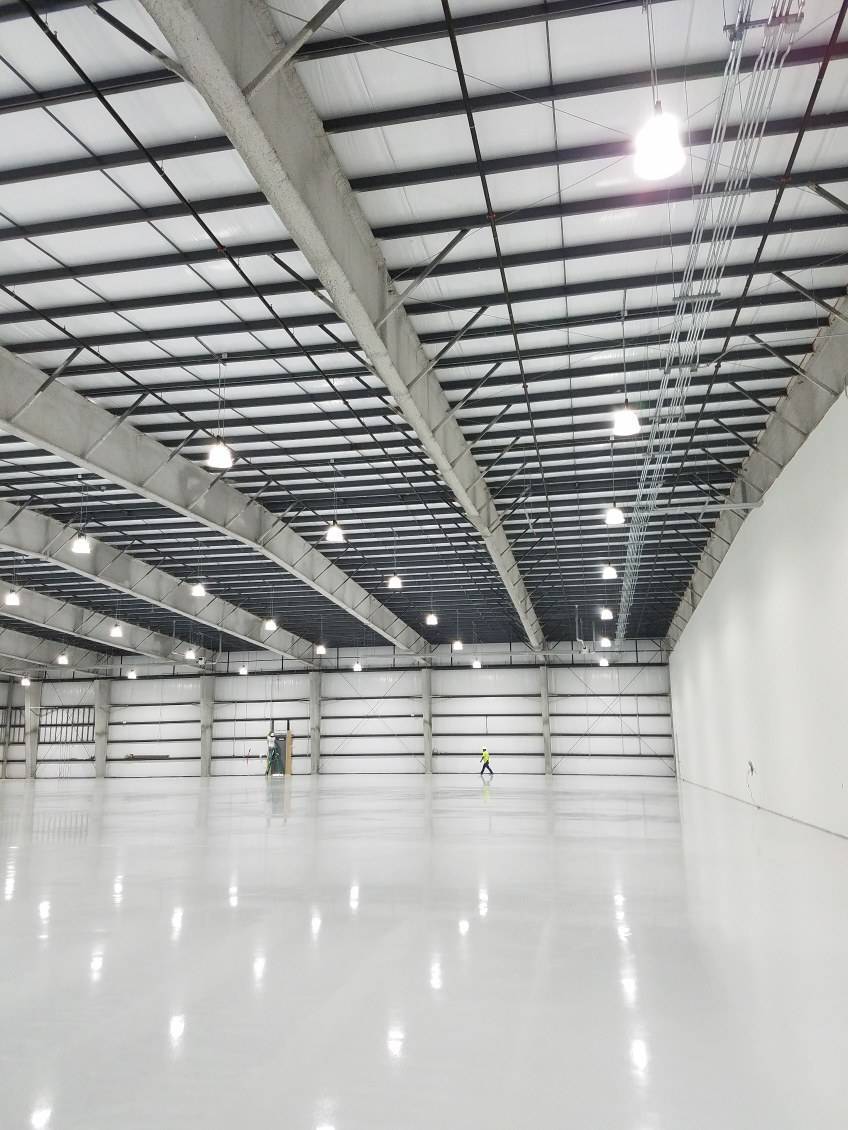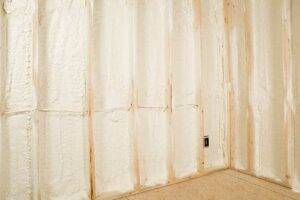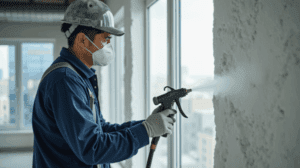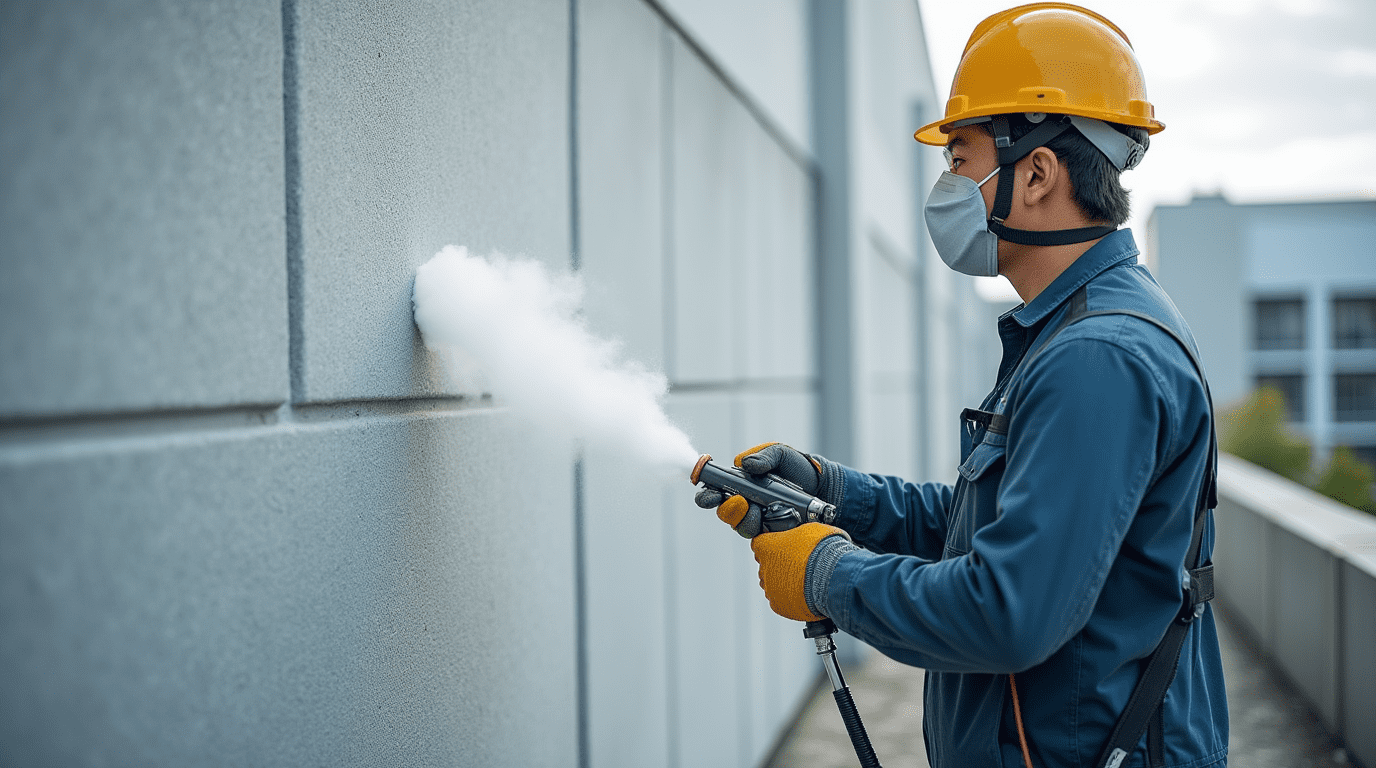K-13 Insulation: Built for Long-Term Performance
Bahl Fireproofing
Commercial buildings demand insulation systems that deliver reliable thermal and acoustic performance over decades of service. K-13 spray-applied cellulose insulation addresses this need through engineered fiber composition, professional installation standards, and inherent resistance to environmental stressors common in commercial facilities. This article examines the material science behind K-13’s durability, proper installation requirements, environmental resilience, sustained performance characteristics, and why facility managers throughout Texas, Kansas, and Oklahoma trust Bahl Fireproofing for K-13 applications that maintain their engineered properties throughout building lifecycles.
TLDR: K-13 spray-applied cellulose insulation achieves long service life through its cellulose fiber matrix bonded with water-based adhesive, providing R-3.7 per inch thermal resistance and acoustic absorption that resists settling, moisture damage, and degradation. Proper installation by certified applicators ensures uniform density and adhesion critical for maintaining performance. The manufacturer’s Environmental Product Declaration cites a 75-year reference service life, while documented installations demonstrate decades of consistent thermal and acoustic function in demanding commercial environments.
Material Science Behind K-13’s Durability
K-13 spray-applied insulation achieves durability through cellulose fibers combined with water-based adhesive that creates a cohesive matrix resistant to mechanical stress and environmental factors. The cellulose fibers are sourced from recycled materials and treated with fire-retardant additives, while the adhesive system bonds fibers to substrates and to each other, forming a monolithic coating.
Cellulose Fiber Structure and Treatment
The cellulose fibers in K-13 undergo treatment with borate-based compounds that provide fire resistance and biological protection. This treatment penetrates fiber bundles to inhibit microbial growth and deter insect activity without compromising the material’s thermal or acoustic properties. The treated fibers maintain flexibility across temperature ranges, allowing the installed insulation to accommodate thermal expansion and contraction without cracking or delaminating.
Water-Based Adhesive System
K-13 uses a patented water-based adhesive that encapsulates cellulose fibers during spray application. This adhesive creates fiber-to-fiber bonds and secures the matrix to prepared substrates. The water-based formulation contains no volatile organic compounds, supporting indoor air quality objectives while providing the cohesive strength necessary for long-term adhesion under typical commercial building conditions.
Thermal Resistance and Dimensional Stability
K-13 provides thermal resistance measured at R-3.7 per inch according to manufacturer specifications verified under ASTM C518 testing standards. The spray-applied nature eliminates joints and gaps present in rigid board systems, creating continuous insulation coverage that maintains rated R-value. The material resists compression and settling, preserving installed thickness and corresponding thermal performance over time.
Professional Installation Requirements
Proper installation directly influences K-13’s functional longevity by ensuring uniform density, complete substrate coverage, and optimal adhesion. Quality application eliminates voids that compromise thermal continuity and creates consistent material thickness critical for maintaining rated performance characteristics.
Substrate Preparation and Application Technique
Effective K-13 installation begins with substrate preparation, including cleaning to remove dust, oil, or contaminants that could inhibit adhesion. Applicators use calibrated spray equipment to maintain manufacturer-specified fiber-to-binder ratios and achieve consistent density throughout the application. Multiple controlled passes build to specified thickness while avoiding overspray or under-application zones.
Density Control and Coverage Verification
Certified applicators conduct on-site density testing during installation to verify the material meets manufacturer specifications. Proper density ensures the fiber matrix maintains structural integrity and preserves both thermal resistance and acoustic absorption properties. Uniform coverage prevents thermal bridging at transitions and penetrations where inconsistent application could create performance gaps.
Why Certification Matters for Long-Term Performance
Licensed K-13 applicators maintain manufacturer certifications that verify knowledge of mixing parameters, spray techniques, and quality control procedures. This expertise prevents installation errors that compromise durability, including under-application that reduces performance, over-application that wastes material, inconsistent density that creates variation, and inadequate adhesion that risks delamination. Certified installation ensures warranty compliance and provides documentation for building inspectors and facility owners.
Environmental Resistance Over Commercial Service Life
K-13’s formulation provides protection against moisture, biological growth, and temperature fluctuations encountered in commercial building assemblies. The borate treatment inhibits mold and mildew while deterring insects, and the water-based adhesive system limits moisture absorption to maintain thermal properties.
Moisture Management and Mold Resistance
The borate-based additives in K-13 actively inhibit fungal growth at fiber surfaces. This treatment, combined with the open-cell structure that allows moisture to dry rather than accumulate, helps preserve both R-value and structural stability in humid environments. Proper building envelope design with appropriate vapor control strategies ensures K-13 performs effectively across climate zones including humid regions of Texas, Kansas, and Oklahoma.
Biological and Physical Stressor Resistance
K-13’s borate treatment discourages insects from nesting within the fiber matrix, reducing damage from biological activity. The cellulose fibers and adhesive binder maintain flexibility across temperature ranges, accommodating expansion and contraction without brittleness or delamination. This thermal stability helps K-13 withstand repeated heating and cooling cycles common in commercial HVAC applications.
Fire Safety Performance
K-13 achieves Class A fire rating with flame spread of 5 and smoke development of 5 under ASTM E84 testing, significantly exceeding the Class A maximum thresholds. The factory-applied fire retardants remain effective long-term, maintaining code-compliant fire performance throughout service life. It’s important to understand that K-13 provides excellent surface fire resistance but is not a replacement for structural steel fireproofing where ASTM E119 fire-resistance ratings are required.
Sustained Thermal and Acoustic Benefits
K-13 maintains thermal resistance and sound absorption over extended service periods by preserving its fiber-binder network. The open-cell structure that provides acoustic benefits remains intact when proper installation prevents compression and settling. According to U.S. Department of Energy research, properly installed insulation systems maintain consistent thermal resistance that reduces commercial building energy consumption throughout their service life.
Thermal Performance Retention
The fiber structure and adhesive system resist compression, preserving thickness required for rated R-value. K-13’s resistance to moisture ingress helps maintain thermal resistance, as water absorption can degrade insulation performance. Manufacturer documentation references a 75-year service life in the product’s Environmental Product Declaration, though actual performance depends on proper installation, building envelope design, and environmental conditions.
Acoustic Absorption Properties
K-13 provides sound absorption with Noise Reduction Coefficient values that vary by thickness and substrate configuration. According to verified testing data, K-13 achieves NRC values ranging from 0.80 at thinner applications to 1.05 at 1.5 inches on ribbed metal deck. The open-cell structure that enables sound absorption maintains performance as the fiber-binder matrix resists compaction under normal commercial building conditions.
Comparison to Alternative Insulation Systems
Understanding K-13’s characteristics relative to other commercial insulation products helps inform material selection decisions:
K-13 Spray-Applied Cellulose:
- Manufacturer EPD cites 75-year reference service life
- Maintains R-3.7 per inch thermal resistance
- Resists moisture, mold, and settling
- Achieves high acoustic absorption (NRC up to 1.05)
Alternative Systems:
- Mineral wool boards provide thermal resistance but require mechanical fastening
- Rigid foam boards can experience shrinkage and UV degradation
- Spray polyurethane foam offers high R-value per inch but may have different acoustic properties
Each system has appropriate applications based on project requirements, and direct performance comparisons should account for specific installation conditions and building envelope design.
Professional K-13 Installation by Bahl Fireproofing
Bahl Fireproofing delivers K-13 installations that maximize durability through certified applicators, quality control processes, and project management that ensures code-compliant results throughout Texas, Kansas, and Oklahoma.
Expertise and Quality Standards
Our certified applicators follow manufacturer protocols and use calibrated equipment to achieve specified density and adhesion. This precision protects the fiber matrix from installation-related stressors that could compromise long-term performance. Regional expertise in Texas, Kansas, and Oklahoma codes accelerates approvals and prevents delays while ensuring compliance with local requirements.
Project Process and Documentation
Facility managers and contractors can request detailed proposals outlining project scope, material specifications, coverage rates, and warranty terms. Our transparent approach enables informed decision-making and provides the documentation necessary for building closeout packages and future reference.
Long-Term Value for Commercial Properties
Investing in professionally installed K-13 insulation delivers sustained thermal resistance that reduces energy consumption, acoustic control that supports occupant comfort, and minimal maintenance demands that lower operating costs. These benefits translate into predictable energy budgets, enhanced occupant satisfaction, and preserved asset value over building lifecycles.
Frequently Asked Questions
What maintenance does K-13 insulation require?
K-13 requires minimal maintenance once properly installed. The monolithic coating resists sagging and settling under normal conditions. Regular inspections should verify physical integrity and check for moisture intrusion at joints or penetrations. The material’s resistance to mold growth and settling means owners rarely need restoration services, reducing lifecycle costs compared to systems requiring frequent intervention.
How does K-13 perform in retrofit applications?
K-13 works effectively for retrofit installations due to its spray-applied nature, which allows application in existing buildings without extensive demolition. The system fills gaps around existing penetrations and provides continuous coverage over irregular surfaces, making acoustic and thermal upgrades practical in older facilities. Appropriate containment and scheduling enable installation in occupied buildings.
What warranty coverage applies to K-13 installations?
Manufacturers typically offer performance warranties covering material properties, while professional installers provide workmanship warranties. Bahl Fireproofing coordinates warranty coverage to ensure comprehensive protection. Specific warranty terms depend on project conditions and should be discussed during bid preparation to align expectations and documentation requirements.
How does K-13 contribute to sustainable building objectives?
K-13 contains 80 percent pre-consumer recycled cellulose fibers, contributing to LEED v4 Material and Resources credits. The product holds GREENGUARD Gold certification for low chemical emissions, supporting Indoor Environmental Quality credits. Sustained thermal resistance reduces building energy consumption, further advancing sustainability goals through operational efficiency.
Can K-13 be applied in humid climates?
K-13’s vapor-permeable structure and borate treatment adapt well to humid conditions by allowing moisture movement through the assembly without trapping condensation. Proper building envelope design with appropriate vapor control strategies ensures effective performance across climate zones. The cellulose fibers provide moisture buffering that helps stabilize relative humidity levels.
What certifications does K-13 meet for commercial applications?
K-13 achieves ASTM E84 Class A fire rating, demonstrating low flame spread and smoke development. The product complies with building code requirements for interior finishes and holds GREENGUARD Gold certification for indoor air quality. These certifications provide assurance regarding safety and environmental performance for commercial specifications.
How does proper installation affect K-13’s service life?
Consistent installation density prevents fiber separation and maintains the cohesive matrix necessary for thermal and acoustic performance. Proper adhesion secures the material against vibration and airflow pressure common in commercial HVAC systems. Expert application eliminates voids and ensures uniform coverage, protecting against premature degradation and maintaining the characteristics outlined in manufacturer specifications.
Key Takeaways
- K-13 spray-applied cellulose insulation achieves durability through engineered fiber composition bonded with water-based adhesive that resists compression, settling, and environmental degradation
- Manufacturer documentation references a 75-year reference service life, with proper installation and building envelope design supporting extended performance in commercial facilities
- The material provides R-3.7 per inch thermal resistance and acoustic absorption with NRC values up to 1.05 depending on thickness and substrate configuration
- Borate treatment offers protection against moisture, mold, and biological activity while maintaining fire-resistant properties throughout service life
- Professional installation by certified applicators ensures uniform density, complete coverage, and optimal adhesion critical for long-term performance
- K-13’s sustained thermal and acoustic benefits reduce operating costs through consistent energy efficiency and occupant comfort over building lifecycles
Partner with Bahl Fireproofing for Reliable K-13 Installation
When your commercial project requires insulation that maintains thermal and acoustic performance over decades of service, professional K-13 installation by certified applicators protects your investment. Our team brings over 20 years of experience to projects throughout Texas, Kansas, and Oklahoma, delivering coverage that meets manufacturer specifications and building code requirements. Contact Bahl Fireproofing today to discuss your insulation needs and receive a detailed project proposal with transparent specifications and warranty terms.
Disclaimer: This article provides general educational information about fireproofing and insulation systems and does not constitute professional engineering advice or product specification. System selection must be based on project-specific fire ratings, thermal requirements, acoustic performance needs, environmental conditions, substrate requirements, and budget constraints. Code requirements vary by jurisdiction and project type. Always consult with a licensed professional and verify UL or FM assembly listings before finalizing specifications.

